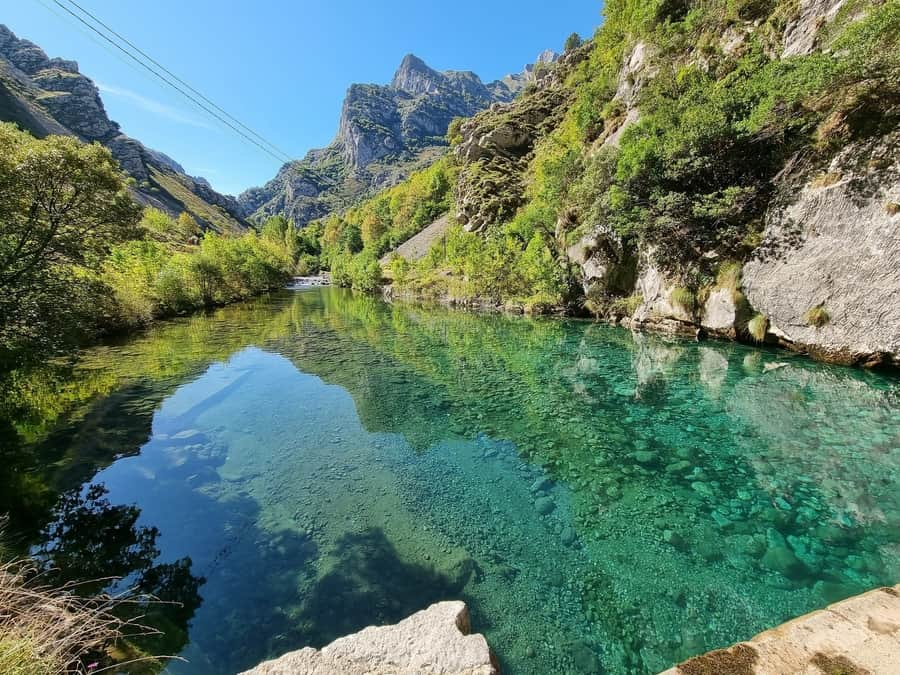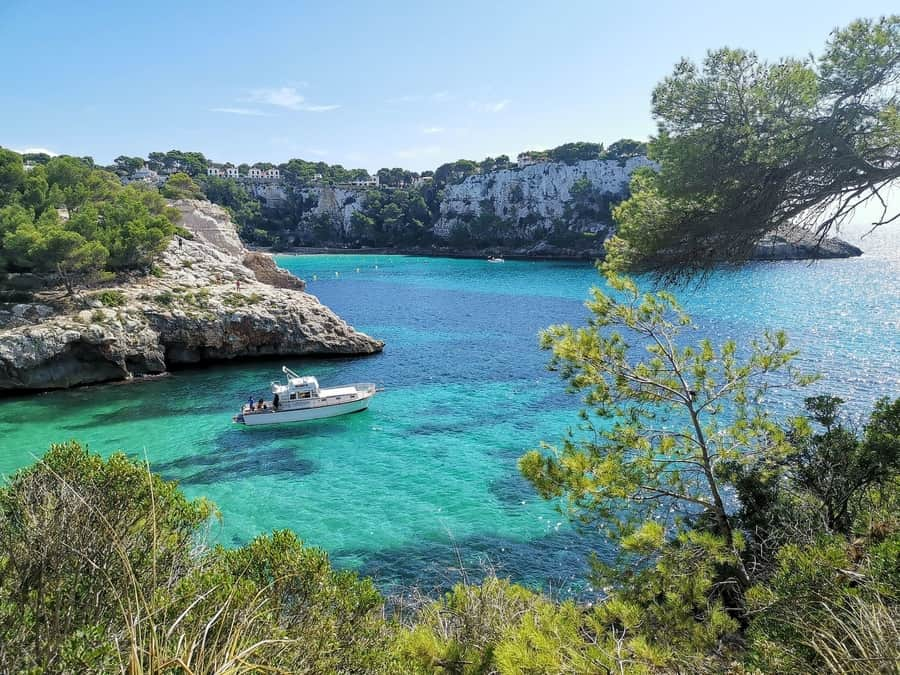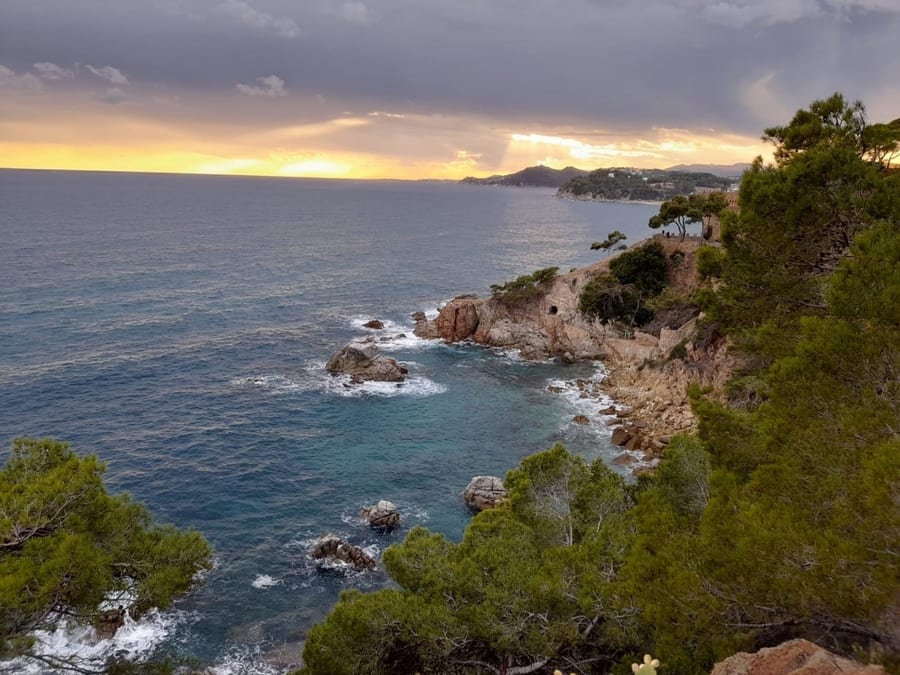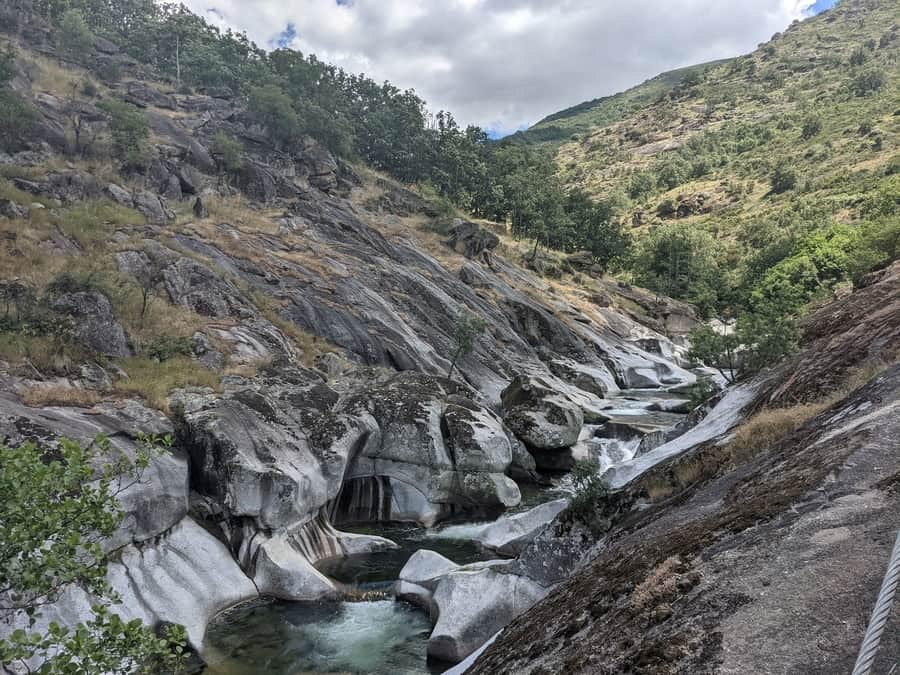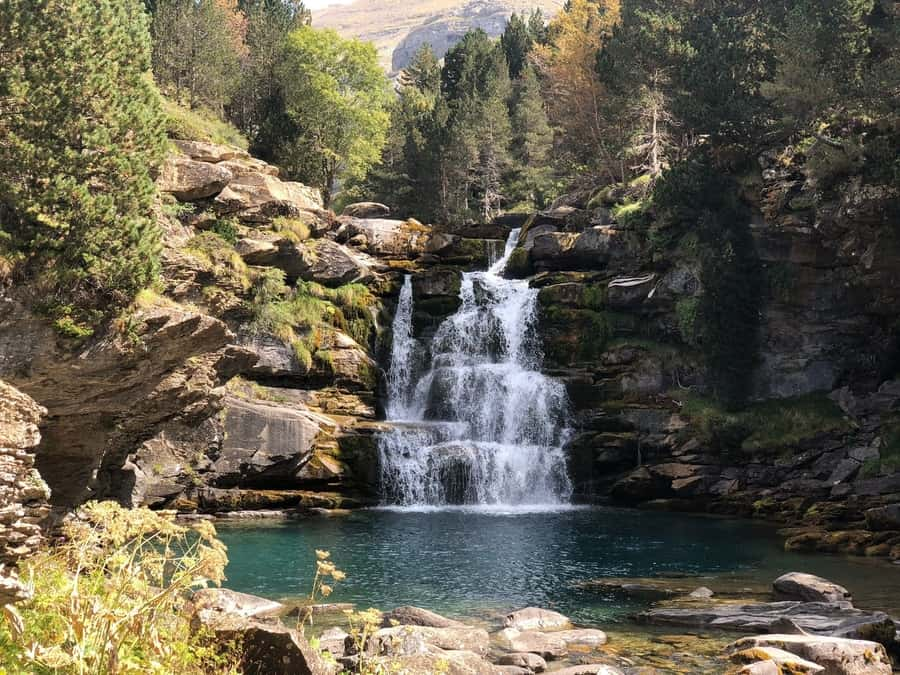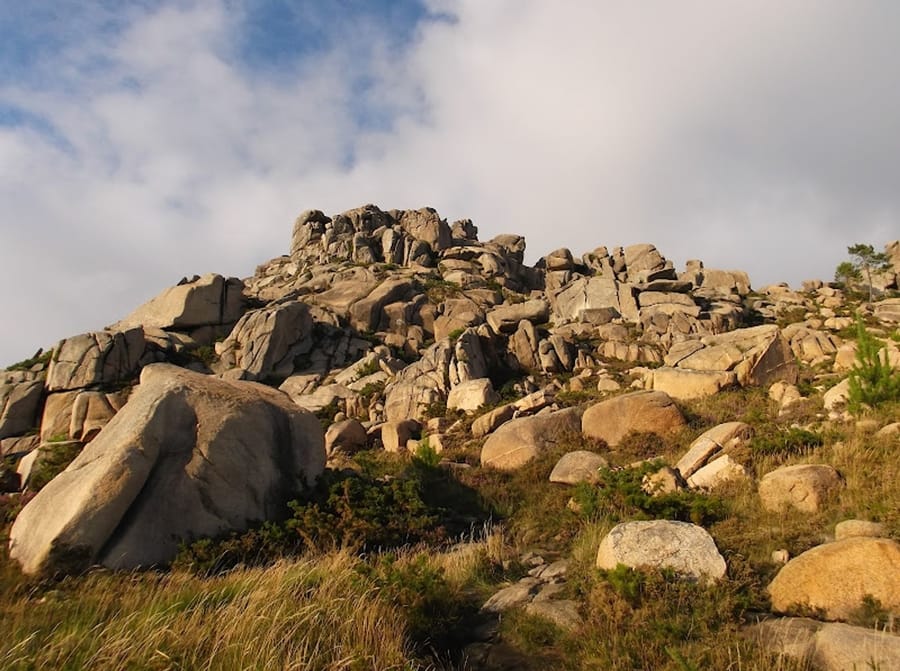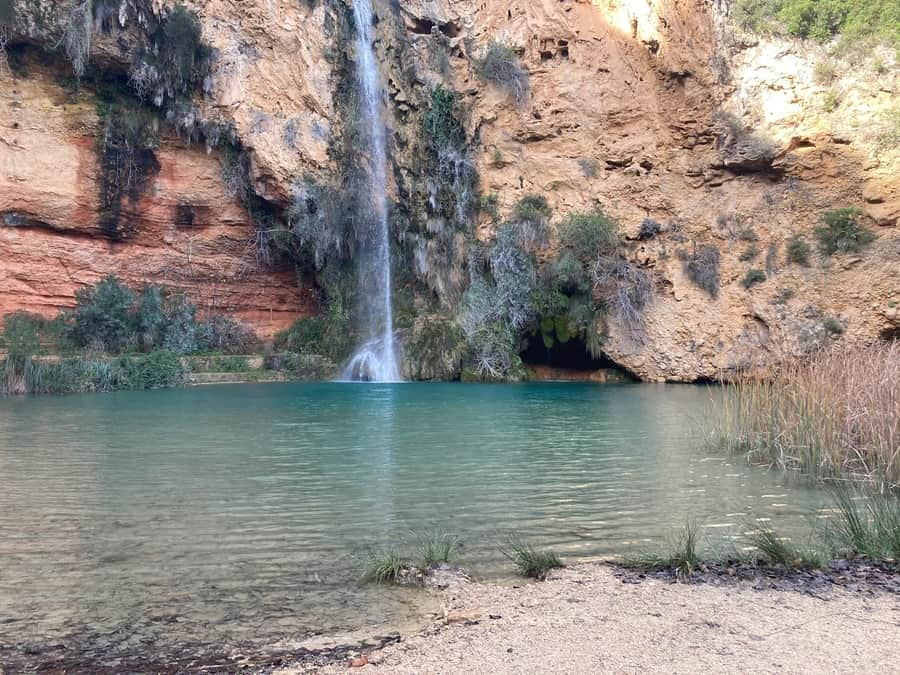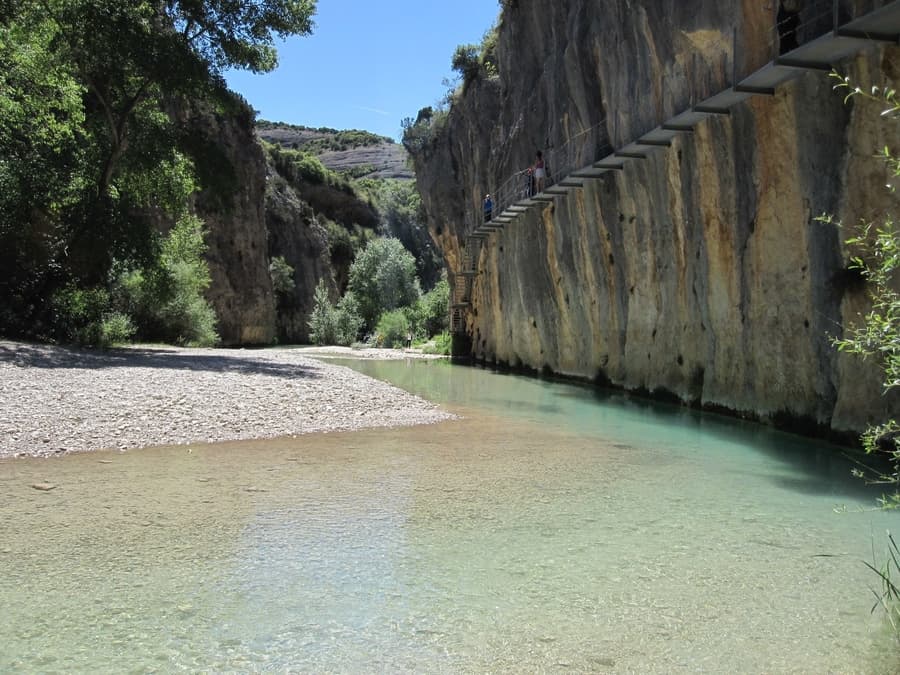There are thousands of miles of hiking trails across Spain, passing through the country`s varied natural landscapes. Some routes run along cliff edges, making them unsuitable for those afraid of heights, but others follow coves with crystal clear water, providing a stunning backdrop for hiking adventures.
Not only is Spain the second most mountainous country in Europe, but its temperatures tend to be mild all year round, allowing you to go hiking in Spain at practically any time of the year. You have numerous choices, but if you want to hike among the finest, I’ve prepared a listing of the 15 best hikes in Spain that will leave you breathless.
Do not worry if you lack experience hiking because these routes through Spain vary in terms of difficulty and duration. Therefore, if you`re prepared to uncover the finest trails in Spain, let`s get started!
1. The Cares Trail, Asturias, the best hike in Spain
The Cares Trail, starting from the Asturian village of Poncebos, is undoubtedly one of the most scenic hikes in Spain. The route is within the limits of the Picos de Europa National Park, one of the finest national parks in Spain, so you cannot miss it.
Known by the name “Divine Throat”, the Cares Trail takes your breath away via its scenery and the profound depths of its green valley, which stands in contrast to the clear waters of the Cares River. The route is carved into the rock, therefore you`ll go through tunnels and gorges, and cross a few bridges.
Initially, the route was established to connect the towns of Poncebos in Asturias and Caín in León, but it ended up as one of the best hiking trails in Spain. If starting from the Asturian section, the beginning involves an incline followed by passing through a narrow gorge with a sandstone floor. You`ll need to stay close to the mountain wall, though it isn`t too difficult (as long as a fear of heights isn`t present, of course).
The gorge narrows as you progress through the Leonese section, and at the end of this Spanish route, the Caín dam and waterfall await you. While the entire route is worth exploring, the views along the way are just gorgeous.
Another choice, if traveling without a vehicle, is to take this all-terrain vehicle tour (in Spanish), which transports travelers from Cangas de Onís to Caín de Valdeón, accompanied by a hike along the Cares Trail.
- Duration: 7-8 hours
- Distance: 13.3 miles
- Difficulty: Hard
- Ideal timing: Year-round, but avoid rainy days
- Type: Out & Back
- Challenges: Steeper slopes initially, stones, goats
- Elevation: 985 ft
- Recommended lodging: Hostal Pancebos is found at the start of the Cares trail
2. Camí de Cavalls, Menorca, one of the best hiking trails in Spain
The Camí de Cavalls is one of the longest hiking routes in Spain, and one of the prettiest. Its original trail, which was used to defend the coast, is 115 miles long and by going through it, you’ll get to see Menorca’s lovely natural setting.
If hiking in the Balearic Islands appeals to you, the Camí de Cavalls is the premier option, even if you do not complete the entire route. That said, if you are physically fit and want to hike its full length, you`ll circumnavigate Menorca`s coastline, passing through ravines, valleys, wetlands, farmland, lighthouses, trenches, and pristine turquoise coves.
Moreover, through undertaking this multi-stage hike across Spain, you’ll personally experience the magnificent natural and cultural heritage of this beautiful island, designated a UNESCO Biosphere Reserve.
Whether you complete the whole trail or just a part, remember to wear good shoes since most of the route is rocky. Also, keep in mind that there are sections of the path where lodging choices won`t be available for several miles. Provided you plan accordingly, I can assure you this hike in Spain is completely worthwhile!
- Duration: Several days
- Distance: 115 miles
- Difficulty: Hard
- When to do it: Year-round
- Type: Loop
- Challenges: Duration, rocky terrain of the trail.
- Elevation: 460 ft
- Suggested accommodation: To begin the route, I propose the spectacular Can Alberti 1740 Boutique Hotel
3. Caminito del Rey, Málaga, one of the most famous hikes in Spain
The scenic Caminito del Rey hiking trail is among the finest routes in Spain for hiking, partly due to its distinctive characteristics, and traversing it ranks among the top activities in Spain.
Situated in the province of Málaga, this pathway is a pedestrian walkway built into the canyon`s stone wall. There are some particularly narrow sections, where the width of the trail scarcely extends beyond one foot. Moreover, the route is nearly 330 feet above the river, so it’s not advised for individuals afraid of heights.
Today, the Caminito del Rey is one of the best trails in southern Spain for hiking. Originally, it was constructed because the Chorro Hydroelectric Company needed access to the area between the waterfalls for maintenance, transporting materials, and surveillance operators to pass through.
Additionally, King Alfonso XIII made the trip to the region in 1921 to officially start the work. He traveled from the Conde del Guadalhorce dam, therefore he had no option except to pass through this path. Since that moment, people began calling it the Caminito del Rey (The King`s Path), and they still do today.
In 1989, the natural environment was designated as a Natural Area by the Junta de Andalucía. The significance of the Desfiladero de los Gaitanes Natural Park, the footbridges spanning the hydroelectric dam, and the Paleolithic cave of Ardales renders this one of the optimal trails in Spain.
General admission, which costs about €10, allows all safety gear and must be booked ahead here. Yet, if you favor a directed version of this path, I suggest this half-day trip, which contains admission to the footbridge, striking sights of the Gaitanes Gorge, and a visit to the King’s Armchair. You’ll also gain more knowledge about the route’s history and geological importance from an informed guide.
- Duration: 3-4 hours
- Distance: 4.2 miles
- Difficulty: Moderate
- When to do it: Avoid days with inclement weather because it usually closes
- Type: One-way
- Obstacles: You must wear a helmet
- Elevation: 899 ft
- Suggested lodging: La Posada del Conde is near the start of this route
4. Congost de Mont-Rebei, Lleida, an amazing hike in Spain
The Congost de Mont-Rebei is one of the most spectacular trails for hiking in Spain. Its vertical walls, which are over a mile tall, separate the provinces of Lleida and Huesca.
If undertaking the full route starting from La Masieta in Lleida and ending in Montfalcó in Huesca, expect about a 10 mile trip total. Most hikers only do the shorter version, turning back after three miles once reaching the Congost de Seguer suspension bridge connecting the two provinces.
If you do continue along this Spanish trail, don`t worry because you`ll have various resting stops where you can take a break and admire the stunning surroundings. Just be aware that towards the end of the hike, there is a steeper incline.
Overall, this is one of the finest trails in northern Spain, thanks to the Noguera Ribagorçana River, which crosses the Montsec mountain range. This forms the Mont-Rebei gorge, which is renowned for its huge vertical walls, making it worth seeing.
- Duration: 2 hours (if you turn around the Congost de Seguer suspended bridge)
- Distance: 3.1 miles (if you turn around on the Congost de Seguer suspension footbridge)
- Difficulty: Moderate
- When to do it: Year-round
- Type: Out & Back
- Obstacles: Steps, bridges, rough terrain
- Elevation: 715 ft
- Suggested lodging: La Casa de Piedra, situated before the Congost de Mont-Rebei, is the ideal starting point for the hike
5. Camino de Santiago, the most impressive hike in Spain
The Camino de Santiago is one of the most prominent hiking trails in Spain, not just nationally, however all throughout the world.
It’s accurate that there are numerous courses that end in Santiago de Compostela, one of the most wonderful cities in Spain. You have the Camino Francés (the French Path), which is the conventional Jacobean route that most global pilgrims do. There is likewise the Vía de la Plata, which emerges from Andalusia and Extremadura and goes through Galicia, the Portelas do Padornelo, and A Canda.
Another historic route to Santiago de Compostela is the Camino Primitivo (the Original Way), which was followed by the earliest pilgrims who arrived from the Kingdom of Asturias. Additionally, the Camino Portugués (the Portuguese Way) became popular following the independence of Portugal. Yet one more path is the Camino del Norte (the Northern Way), which traverses the Asturian-Galician coast and dates back to when the tomb of the apostle Santiago was discovered.
All of these routes involve multi-day hikes in Spain, so you should be physically fit if you plan to complete them. Again, this is considered one of the premier trails in Spain, thanks to its atmosphere, its importance, the scenery, and the people you’ll meet along the way. So, I recommend undertaking at least one of thesecaminos if possible!
- Duration: Several days
- Distance: Depends on the route chosen
- Difficulty: Hard
- Best time: It`s preferable to go when temperatures aren`t as cold
- Type: One-way
- Obstacles: Duration
- Height: Depends on the route chosen
- Highlighted lodging: Upon arrival, you will find the magnificent Hostal Reis Catolicos ready to greet you, one of the best inns in all of Spain highlighted for its beauty.
6. Barranco de Masca, Tenerife, the best hike in Spain’s Canary Islands
The Barranco de Masca gorge is one of the finest treks in Spain and a single of the utmost dramatic activities to carry out in Tenerife. It’s the second most frequented natural destination on the island, exceeded merely by Mt.Teide.
This hiking route in the Canary Islands starts in the Caserío de Masca, a remote village raised between mountains. The path is most renowned for its climb and descent along the Masca ravine, leading to the beach of the same name.
When we completed this hiking path in Tenerife, it was possible to take a watercraft from Masca Beach to Los Gigantes. Regrettably, the pier isn’t operational presently, so you have to do the return trip on foot, which renders this one of the most challenging treks in Spain.
If you decide to do this route, I suggest reading our guide to the Barranco de Masca. There, you’ll find more information about the permit, schedules, requirements, and other helpful tips about this hike.
Ultimately, this is one of the best routes for winter hiking in Spain, thanks to the mild climate that Tenerife enjoys throughout the year.
- Length: 3 hours for the descent, 4 hours for the ascent
- Distance: 3.1 miles one-way (6.2 miles round-trip)
- The descent requires moderate effort, while the ascent demands a high degree of exertion.
- Best time: Year-round, but avoid weekends if possible.
- Type: Out & Back
- Obstacles: Uneven terrain during ascent, slippery surfaces
- Elevation: 2,460 ft
- Recommended lodging: The Sweet Home Masca is the ideal rural escape in Tenerife
7. Camí de Ronda, one of the best hikes in Spain along the Costa Brava
One of the premier locations for hiking in Spain is the Costa Brava, particularly along the Camí de Ronda. If you complete the entire route (260 miles), you`ll likely begin in Blanes and end in Portbou, though you can modify the path to shorten it or fashion it as a roundtrip. In any case, this trail stands out for its charming towns, beaches, and coves that you’ll encounter along the way.
Furthermore, the name of this hiking trail in Spain became well-known in the 19th and 20th centuries when it was utilized by the civil guards to conduct ‘rounds’ and check for smugglers along the coast.
Something important to keep in mind if wanting to do this hike is having insurance covering hiking and similar activities. When we went, we purchased a policy through Heymondo travel insurance, which I highly recommend.
Whether you do the whole route or just a section, this path will allow you to see the sea and even take a dip along the way. The key thing to remember is good mountain/hiking footwear and trekking poles and, depending on the time of year, a hat to block out the sun. Also, you’ll want to bring a swimsuit so you can quickly jump into the water to cool down!
- Duration: Several days
- Distance: Depends on which route/section you take
- Degree of difficulty: Varies depending on the route, but generally moderate.
- When to do it: Year-round
- Type: One-way
- Obstacles: Slopes, continuous ups and downs
- Elevation varies depending on the section, but the path is generally level.
- Suggested accommodation: If you do the section that passes through Cadaqués, don’t miss the Hotel Playa Sol
8. Garganta de los Infiernos, Cáceres, another one of the best hikes in Spain
One of the most breathtaking routes for backpacking in Spain is the Garganta de los Infiernostrail. It lies within the Garganta de los Infiernos Nature Reserve in the Valle del Jerte of Cáceres, renowned for its springtime cherry blossoms.
I highly recommend this hiking trail in Spain since it has plenty of shade and natural pools. Besides being good for taking a refreshing swim, the route offers lovely views of the entire valley and gorge.
The surroundings are very picturesque, especially the waterfalls. Part of the route also follows the Carlos V Trail, which the emperor Carlos V utilized as a shortcut en route to Laredo.
In addition, the area of Los Pilones, possessing its immense kettles, and the Chorreo de la Virgen, characterized by a tremendous waterfall visible from the viewpoint located at Chorreo (in summer it may dry up), represent two of the most appealing sections of the trail.
- Duration: 5 hours
- Distance: 9.3 miles
- Difficulty: Moderate
- Optimal timing: Throughout the year, but it is most picturesque in spring thanks to the cherry blossoms, and in summer when swimming is possible. It is best avoided in winter when sheets of ice form along the pathway.
- Type: Loop
- Obstacles: Narrow trails and portions of uneven terrain
- Elevation: 2,260 ft
Humpback whales can be seen in the longest fjord in the country, Eyjafjord. The tour lasts 3 hours and if whales are not spotted by the end, a coupon valid for 2 years will be provided to repeat the tour from Reykjavík.
9. Cola de Caballo through the Gradas de Soaso waterfalls in Ordesa, Spain
The Cola de Caballo route is the most renowned hike in Spain’s Ordesa Valley, and one of the best-known paths in the Pyrenees.
By undertaking this hike, you’ll be able to enter the extensive glacial valley of Ordesa, which was declared a UNESCO World Heritage Site in 1997 and is considered one of the most visited national parks in Spain.
This hike in the mountain range located in northeastern Spain commences in the Pradera de Ordesa natural area and follows the Arazas River through the valley until reaching the cascading Soaso waterfalls. During the excursion, you’ll be able to admire the walls of the valley, which have been shaped by the erosion of the ancient glacier. You can also enjoy the various cascading sections of the Arazas River, including the Arripa and Estrecho falls.
As one of the top hikes in Spain, this route is extremely popular, so there are usually lots of people here, especially in summer.
- Duration: 5-6 hours
- Distance: 10.9 miles
- Difficulty: Hard
- When to do it: Spring, summer, or fall
- Type: Out & Back
- Obstacles: The length
- Elevation: 1,640 ft
- Recommended lodging: The Edelwesiss Hotel, in the village of Torla, is the top place to remain along this route.
10. La Pedriza, Madrid, a great place to go hiking in Spain
There are many hiking routes in the Sierra de Guadarrama mountains, but if you’re seeking one of the best hikes in Spain that can be done from Madrid, I recommend the La Pedriza-Canto Cochino-Charca Verde course near Manzanares el Real.
This is a delightful path through the mountains of Madrid, and a hike that you can take as a family group. The initial section, from Pedriza to Canto Cochino, requires about 30-40 minutes, with the Manzanares River located on your left side. You’ll arrive at a viewpoint furnishing beautiful perspectives of La Pedriza.
Along the path to Charca Verde, you’ll pass two additional scenic overlooks with panoramas of the loftiest peaks of the Sierra de Guadarrama. You’ll enjoy the entire route, so if you’re in central Spain and seeking fresh air and nature, this is an amazing trek in Madrid worth experienxing.
- Duration: 4 hours
- Distance: 7.5 miles
- Difficulty: Moderate
- When it should be done: Throughout the year, although slippery rocks can be present when it rains
- Type: Loop
- Obstacles: Small waterfalls
- Elevation: 1,653.5 ft
- Recommended area to remain: You need not hesitate to reside at the Hotel Rural La Pedriza Original, which offers elegant rooms, a library and TV space, a rustic garden, and a play area.
11. Saliencia Lakes, Asturias, one of the best hikes in Spain in the north
The Saliencia Lakes lie in the stunning Somiedo Natural Park and boast some of the best hiking trailsin northern Spain.
The trail lies in southern Asturias, near the boundary with Castilla y León. Its four ice-age lakes (Cueva, Calabazosa, Cerveriz, and Almagrera) are part of the Somiedo Biosphere Reserve and have been declared a Natural Site.
The route initiates from Alto de la Farrapona in Somiedo, and while you should be in good form, you don’t need to be an experienced hiker to do it.
The foliage in the region takes on a lovely hue from September to December, which is why I believe it’s one of the finest Spanish excursions to undertake during autumn. I suggest staying here for at least one day so you can experience this impressive park, including its native brown bears, mountain goat species, and other fauna.
- Duration: 6-8 hours
- Distance: 8.7 miles
- Difficulty: Moderate
- When to do it: Spring, summer, or fall
- Type: Loop
- Obstacles: Long path
- Elevation: 1,312 ft
- Recommended lodging: The Apartamentos Lagos de Saliencia are situated right in Saliencia, and provide excellent accommodations.
12. Monte Pindo, Galicia, among the most famous hikes in Spain
The ascent to Mount Pindo, also referred to as the Celtic Olympus, is one of the prime places to trek in Spain during the summer months.
This route starts from the San Clemente do Pindo church, in front of San Pedro Beach. Along the trail, and as you go up, you’ll be able to enjoy spectacular views of the Costa da Morte. The vantage point is even better at the peak of A Moa, which is nearly 1,970 feet high.
As you undertake this Spanish hike, you’ll traverse between rocks, granite cliffs, pine trees, and ferns, and you’ll pass through the remnants of the medieval San Xurxo castle, which once defended the coast against pirates. Also, be sure to observe O Guerreiro, a famous rock formation that resembles a giant human figure.
Ultimately, you can also tackle this hiking trail in a circular route, and with less uneven terrain, if you commence from O Fieiro.
- Duration: 4 hours
- Distance: 6.2 miles
- Difficulty: Moderate
- When to do it: Year-round, although it’s best to avoid rainy weather
- Type: Loop
- Obstacles: Formations can make navigating the terrain difficult.
- Elevation: 2,058 ft
- Recommended accommodation: Stay in O Pindo, in the Hospedium Morada da Moa
13. Ruta del Agua Buñol, Valencia, the best hike in Spain to do in spring
The Hoya de Buñol water route is one of the best hiking trails in Spain and one of the natural wonders of Valencia. Plus, it’s only 25 miles from the capital city.
The trail starts at the Parque de San Luis, in Buñol, and continues along the Paseo del Parque Fluvial, next to the Buñol riverbed. Along the route, you’ll pass the Molino Galán, next to a large chimney dating back to the town’s significant paper industry. Today, it’s a multi-purpose cultural center.
This round route provides the opportunity to view the Cueva del Turche, and people can see a waterfall after heavy rainfall. Beautiful perspectives can be enjoyed at the Mirador de la Cueva del Turche, and visitors can take a dip in the Charco Mañán, which offers relief on hot days when completing this hike.
This trail also passes through the Cueva de las Palomas, which is known for its beautiful waterfall scene. While this route is quite uncomplicated, you should pay careful attention to the trail markings. I recommend going after the coldest period of winter has passed since it’s one of the most lovely paths in Spain during the springtime season.
- Duration: 3 hours
- Distance: 5.9 miles
- Difficulty: Moderate
- When to do it: It’s prettiest in the spring
- Type: Loop
- Obstacles: You’ll pass through some rocks
- Elevation: 860 ft
- Recommended accommodation: The Molino Galán in Alborache is a very pleasant place including a garden, outdoor pool, and barbecue area
14. Pasarelas del Vero, Huesca, a little-known hike in Spain you should do
The Pasarelas del Vero trail originates in the Plaza Rafael Ayerbe de Alquézar, one of the most beautiful small towns in Spain, therefore it’s the perfect choice if touring is the reason for being there.
Bear in mind that before embarking on this hike in Spain, you must obtain a permit through this website. The fee is approximately €4 for hikers over 12 years old and it will indicate the designated time slot for trail entry. The permit purchase also includes a helmet and insurance coverage.
At the beginning point of this hiking trail situated in Spain, you will descend from Alquézar to the Vero River via the Barranco de la Fuente. It is confined amidst limestone walls, with the Collegiate Church of Alquézar being located at the top close to the right side and the Peña Castibián being located to the left.
Once you reach the riverbed, visit the Picamartillo Cave if possible. Then, continue through the suspended walkways to see the infrastructure of the old Hydroelectric power plant. Keep ascending and go through the last section to the Mirador del Vero, where you can enjoy the spectacular views.
Upon returning to Alquézar, you’ll pass through orchards as well as groves of almond and olive trees, so it’s one of the finest trails in Spain to hike through in the fall season.
- Duration: 1.5 hours
- Distance: 1.9 miles
- Difficulty: Easy
- When to do it: Year-round, but autumn is best. Try to avoid doing it on rainy days or just after, since the ground will be more slippery
- Type: Loop
- Obstacles: Irregular and narrow path sections
- Elevation: 590 ft
The easiest way to know how much travel protection will cost you is to quickly set up a quote less than half a minute here. It primarily depends on the duration of your journey.
15. Sant Jeroni Summit Loop, Barcelona, another famous hike in Spain you can’t miss
Another town with some remarkable hiking opportunities in Spain is Monistrol de Montserrat in Barcelona. Here, you can find the beginning of the Sant Jeroni Summit Loop, which takes you through the forest before the stone peaks emerge as you ascend.
The trail starts at the Montserrat monastery, which you can access by cable car, from the Montserrat-Aéreo train station of the FFCC de la Generalitat. You can also get there via the Monistrol railway.
From there, you can take the Sant Joan funicular to the top or walk upwards. I advise checking out the exhibit at the Parque Natural de la Montaña, in the upper station’s building. Afterwards, continue walking along one of the best hiking routes in Spain to the summit of Sant Jeroni. It’s more or less flat, except for the end, and from there, you can see the towns surrounding the massif.
- Duration: 2-4 hours
- Distance: 4.5 miles (5.8 if completed fully)
- Difficulty: Moderate
- When to do it: Year-round
- Type: Loop
- Obstacles: Stairs at the end
- Elevation: 1,978 ft
- Suggestedlodging: Stay at the Abat Cisneros Montserrat Hotel, next to the Montserrat Monastery, which dates back to 1563
To conclude this guide, I’m sharing a map showing the most important hikes in Spain, so you can clearly see where each trail is situated.
If you have any questions or you’d like to share your experience hiking in Spain, leave me a comment below. I’ll be happy to answer you. Until then, have a nice hike!
